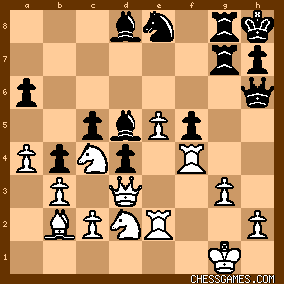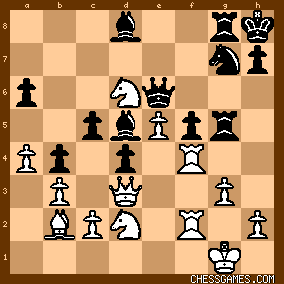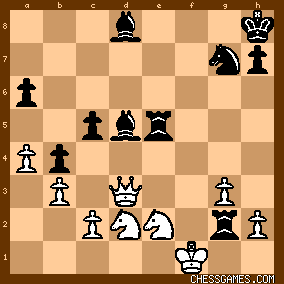Oct-31-04
 | | keypusher: This game won the second brilliancy prize at Hastings, after Steinitz' famous win. Steinitz vs Von Bardeleben, 1895
Steinitz deserved his prize, especially since Tarrasch had a lousy position for most of the game. But the final combination is a stunner. Check it out! |
|
Sep-16-06
 | | chancho: An incredible combination by the "Praeceptor Germaniae." |
|
May-01-07
 | | chancho: It's truly surprising that this famous game is not getting the comments other games in this site are getting. Particularly so when you see the gorgeous combination that Tarrasch came up with to win this game. |
|
| May-01-07 | | whiteshark: brilliant !!! |
|
| Nov-30-07 | | newzild: My final reaction was ... whoa! |
|
| Jun-24-08 | | Lutwidge: Walbrodt was a little cooperative here, but still one of the funkier combinations on record. |
|
| Apr-01-09 | | WhiteRook48: 38 Rg4! is brilliant, uncovering a pin like that, with mate threats with the pin |
|
| Jul-05-11 | | newzild: 32. Nd6 ignites amazing complications. I suspect that Tarrasch did not see it all the way to the end. |
|
| Dec-22-11 | | Nerwal: The position after 29. g3 is quite interesting. The fact that black lost the game probably led Tarrasch and others to the claim that 29... gxf4 was a mistake, but it rather looks like the manoeuver Ne8-g7-h5 was to blame as it breaks the coordination of the black pieces. Tarrasch recommended instead 29... g4, and then play along h file with h7-h5-h4xg3 etc., but this is slow and like in the game, white will just play Nd6 at some point and disturb black's plans by applying pressure on f5. Instead, Pillsbury's recommendation of 29... Bc7, a prophylactic move to prevent all this Nd6 counterplay, looks better and probably keeps black's advantage, but why can't black go for the straightforward, and natural as it includes the queen into the attack, 29... gxf4 30. gxf4 Qh6. In the subsequent lines, the f5 pawn is not important, and quite often black can use the open f file for his attack. The variation are quite complicated, eg 31. Qxf5 Nc7, or 31. Rxf5 Qh3 32. Nf1 Bh4 and then either 33. Rh5 Rf8 or 33. Kf2 Rg5 34. Rf4 Rg4, but black seems close to a decisive advantage; at any rate he would maintain some strong pressure on white's camp. But maybe all this indicates that white's position isn't as "completely lost" as commentators have claimed : everywhere he keeps some interesting defensive resources or at least forces black to be very precise in his attack. Sure enough, 38. Rg4 is a beautiful move. |
|
Mar-12-14
 | | tamar: Tarrasch was not too pleased with Pillsbury's note to 33...Nh5, and gave his own variation that the editor included. Pillsbury < Not seeing White's beautiful counterstroke, 33...Ne6 gave Black a good game, for if then 34 Rh4 Rxg3+ followed by 35...Bxh4 leaves White in a hopeless position.> Cheshire <Dr. Tarrasch has since given the following as the probable continuation if Black had played as suggested above: 33...Ne6 34 Re4 Bxd4 35 Qxe4 Qxe4 36 Nxe4 and now although an exchange behind, White has a strong attack...> The computer evaluation is somewhere in between. It backs up Pillsbury that anything other than 34 Re4 is probably losing, but it also gives that move a small disadvantage, finding resources for Black that Tarrasch did not see. |
|
Mar-12-14
 | | tamar: Who was right, Pillsbury or Tarrasch?
Pillsbury as annotator thought that Black had brought White's attack to a
"standstill" with 21...f5, and that the strength of the bishop on d5 becomes "more and more apparent" His suggestion of 29...Bc7 to keep the knight off d6 is defensive however, and probably only good enough for a draw. So 29...gxf4 30 Rxf4 may be the moment where both Pillsury and Tarrasch missed an improvement for Black. I investigated with Komodo and Stockfish DD Nerwal's great suggestion 30...Qh6! 
click for larger viewThe idea is to pile up on g3, and although the lines are very long, White does not appear he can escape. 31 Rxf5 Qh3 32 Nf1 Bh4 33 Kf2 Rg5 34 Rf4 Rg4 35 Rf3 Nc7 36 Bc1 Bxf3 37 Qxf3 Rg4-g7 38 Qg2 Qe6 (Komodo exchanged Queens, but was unable to overcome White's fortress-Stockfish had the idea of Rg4-g7 allowing the Queen retreat to e6) 39 Kg1 Nd5 (a more aggressive posting of the knight
finally pushes the assessment to a win for Black) 40 Nb2 Be7 41 Bd2 Rf8 42 Re1 h5 43 Nd3 h4 44 a5 Rh7 45 Qe4 Rhf7 46 gxh4 Nc3 47 Bxc3 dxc3 48 Ng3 c4 49 bxc4 Qh3 50 e6 Rg7 51 Qd4 Bxh4 52 e7 Bxe7 53 Nf4 Bc5 54 Ng6+ Kg8 55 Qxc5 Rxg6 56 Qd5+ Kh7 57 Qd3 Black is winning with the threats on g3 still going strong, and can now trade queens with 57...Qf5 when he will push his Queenside pawns. |
|
| Nov-15-14 | | TheBish: <chancho: It's truly surprising that this famous game is not getting the comments other games in this site are getting. Particularly so when you see the gorgeous combination that Tarrasch came up with to win this game.> Yes, surprising that it isn't listed as one of Tarrasch's "Notable Games", or as a "Game of the Day", or a POTD! Or all three! |
|
Dec-01-14
 | | offramp: When you've just won a game like this what do you do? What does one say? How does one stand? What gestures does one make? What wine does one drink? |
|
| May-03-15 | | DrGridlock: Cool 19'th century game - and the type of game it was almost impossible to completely understand without a computer. In "The Modern Chess Self-Tutor, Bronstein gives 2.5 pages of analysis to the position after 32 Nd6. Siegbert Tarrasch - Karl August Walbrodt

click for larger view"Here in the first instance, one must study the forcing variation 32 ... Nh5, 33 Rxf5 Nxg8, 34 Rxg5 Bxg5, 35 hxg3 Be3." Bronstein goes quite deep into this variation, examining a white knight check on f7, defended by a black queen sac on f7, and whether or not white can accept this queen sac. Bronstein concludes, "The reader will agree, no doubt, that for such a position there was some point in going for the audacious attack 32 ... Nh5. ... Instead of the energetic move 32 ... Nh5 the young Walbrodt ... made a move that was passive, although in doing so he captured a white pawn: 32 ... Qxe5." Bronstein then quotes Pillsbury's observation, "The position admits of beautiful possibilities, and Black permits himself to be outgeneralled by his more experienced opponent. It was not wise to take this pawn and it is a violation of principles to put one's king and queen on the same diagonal with an adverse bishop, and Black pays dearly for it." Such has been the understanding of this position for over 100 years. Black committed a "violation of principles" and by lining up his queen and king on the a1 - h8 diagonal lost the game. No need to provide a variation showing black's loss, it is sufficient to quote a principle, and to show that black lost the game. Komodo finds that after:
32...Qxe5
33.Nxf5 Rf8 (black's saving defensive resource)
34.Nxd4 Rxf4
35.Ne2 Rxf2
36.Bxe5 Rg2+
37.Kf1 Rxe5
Siegbert Tarrasch - Karl August Walbrodt

click for larger viewBlack has traded his queen and a pawn for two rooks and a bishop, and his rooks are swarming around black's king in a position Komodo judges as roughly equal, but more favorable to black: -.37. While Bronstein was fascinated with 32 ... Nh5, it's a playable but not best alternative for black on move 32. At move 33 ... Nh5 is the losing move for black, who might have won the game had he continued 33 ... Rf8. The key is to look into concrete lines, and not to rely on "violation of principles." |
|
Oct-07-17
 | | offramp: <DrGridlock: Cool 19'th century game...> Agreed. It looks pretty modern for a 19thC game. It looks more modern than the 1st Brilliancy Prize winner, Steinitz vs Von Bardeleben, 1895. Walbrodt must have been truly choked up. He had never beaten Tarrasch (he never did), but here it looked for a while as if he had the Master on the ropes. |
|
| Dec-04-22 | | tbontb: This brilliancy prize game is dynamically equal for a long time until Black Waldbrodt misses his chance of 33....Rf8 34.Rxd4 cxd4 35.Bxd4 Qxf5 35.Rxf5 Rgxf5 to leave White Tarrasch struggling. Instead, 33....Nh5 as played loses immediately to a pretty attack on the d4-h8 diagonal. |
|
|
|
|





